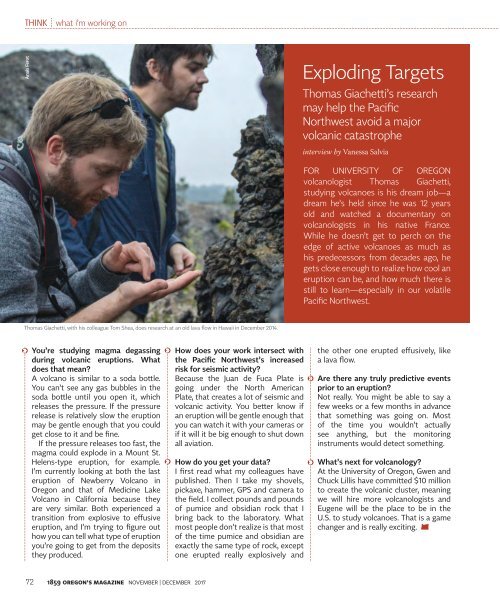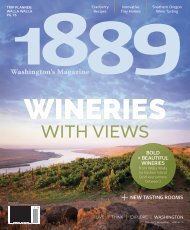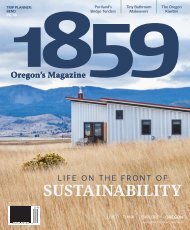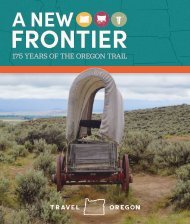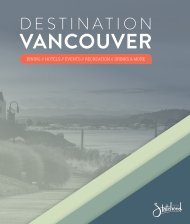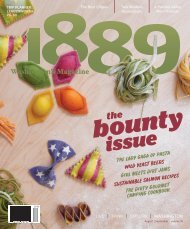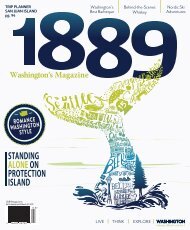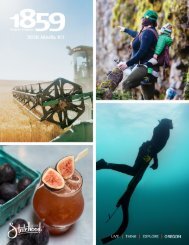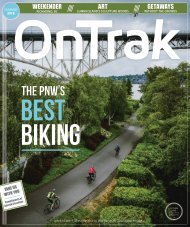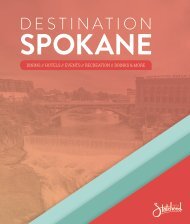Create successful ePaper yourself
Turn your PDF publications into a flip-book with our unique Google optimized e-Paper software.
what i’m working on<br />
Anais Ferot<br />
Exploding Targets<br />
Thomas Giachetti’s research<br />
may help the Pacific<br />
Northwest avoid a major<br />
volcanic catastrophe<br />
interview by Vanessa Salvia<br />
FOR UNIVERSITY OF OREGON<br />
volcanologist Thomas Giachetti,<br />
studying volcanoes is his dream job—a<br />
dream he’s held since he was 12 years<br />
old and watched a documentary on<br />
volcanologists in his native France.<br />
While he doesn’t get to perch on the<br />
edge of active volcanoes as much as<br />
his predecessors from decades ago, he<br />
gets close enough to realize how cool an<br />
eruption can be, and how much there is<br />
still to learn—especially in our volatile<br />
Pacific Northwest.<br />
Thomas Giachetti, with his colleague Tom Shea, does research at an old lava flow in Hawaii in <strong>Dec</strong>ember 2014.<br />
You’re studying magma degassing<br />
during volcanic eruptions. What<br />
does that mean?<br />
A volcano is similar to a soda bottle.<br />
You can’t see any gas bubbles in the<br />
soda bottle until you open it, which<br />
releases the pressure. If the pressure<br />
release is relatively slow the eruption<br />
may be gentle enough that you could<br />
get close to it and be fine.<br />
If the pressure releases too fast, the<br />
magma could explode in a Mount St.<br />
Helens-type eruption, for example.<br />
I’m currently looking at both the last<br />
eruption of Newberry Volcano in<br />
Oregon and that of Medicine Lake<br />
Volcano in California because they<br />
are very similar. Both experienced a<br />
transition from explosive to effusive<br />
eruption, and I’m trying to figure out<br />
how you can tell what type of eruption<br />
you’re going to get from the deposits<br />
they produced.<br />
How does your work intersect with<br />
the Pacific Northwest’s increased<br />
risk for seismic activity?<br />
Because the Juan de Fuca Plate is<br />
going under the North American<br />
Plate, that creates a lot of seismic and<br />
volcanic activity. You better know if<br />
an eruption will be gentle enough that<br />
you can watch it with your cameras or<br />
if it will it be big enough to shut down<br />
all aviation.<br />
How do you get your data?<br />
I first read what my colleagues have<br />
published. Then I take my shovels,<br />
pickaxe, hammer, GPS and camera to<br />
the field. I collect pounds and pounds<br />
of pumice and obsidian rock that I<br />
bring back to the laboratory. What<br />
most people don’t realize is that most<br />
of the time pumice and obsidian are<br />
exactly the same type of rock, except<br />
one erupted really explosively and<br />
the other one erupted effusively, like<br />
a lava flow.<br />
Are there any truly predictive events<br />
prior to an eruption?<br />
Not really. You might be able to say a<br />
few weeks or a few months in advance<br />
that something was going on. Most<br />
of the time you wouldn’t actually<br />
see anything, but the monitoring<br />
instruments would detect something.<br />
What’s next for volcanology?<br />
At the University of Oregon, Gwen and<br />
Chuck Lillis have committed $10 million<br />
to create the volcanic cluster, meaning<br />
we will hire more volcanologists and<br />
Eugene will be the place to be in the<br />
U.S. to study volcanoes. That is a game<br />
changer and is really exciting.<br />
72 <strong>1859</strong> OREGON’S MAGAZINE NOVEMBER | DECEMBER <strong>2017</strong>


